



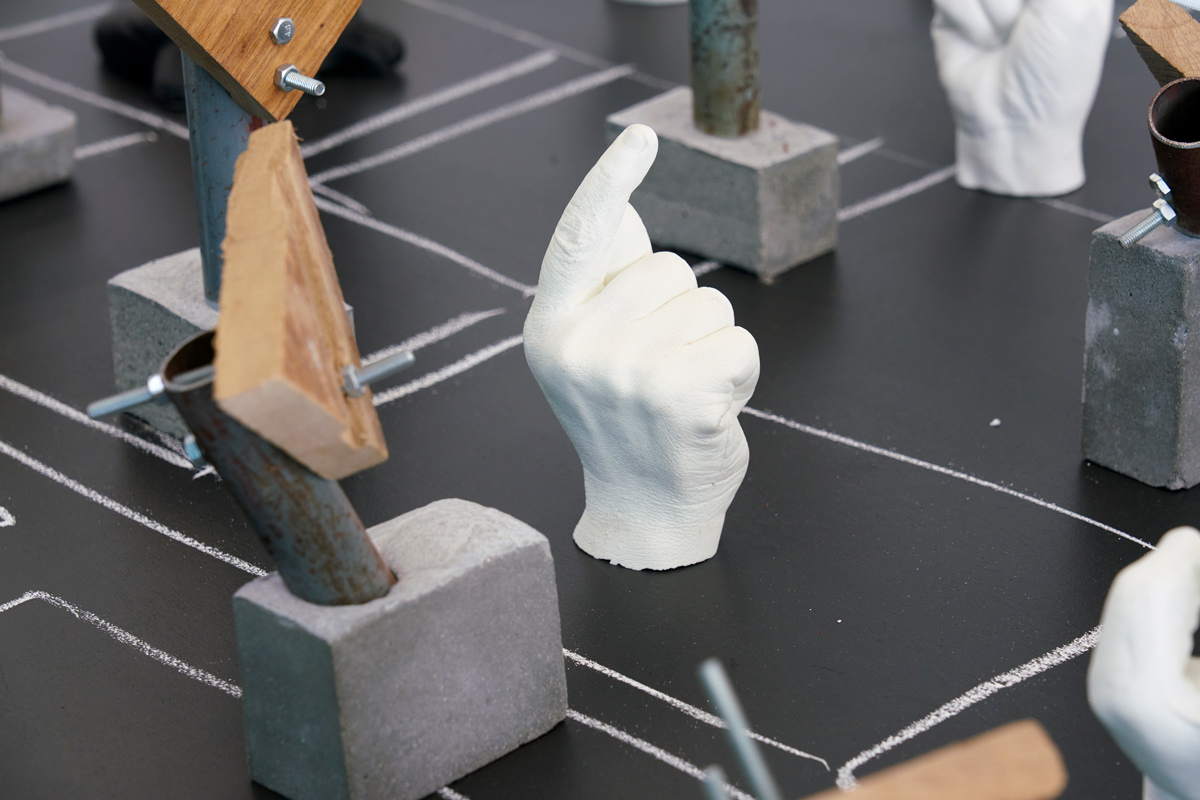
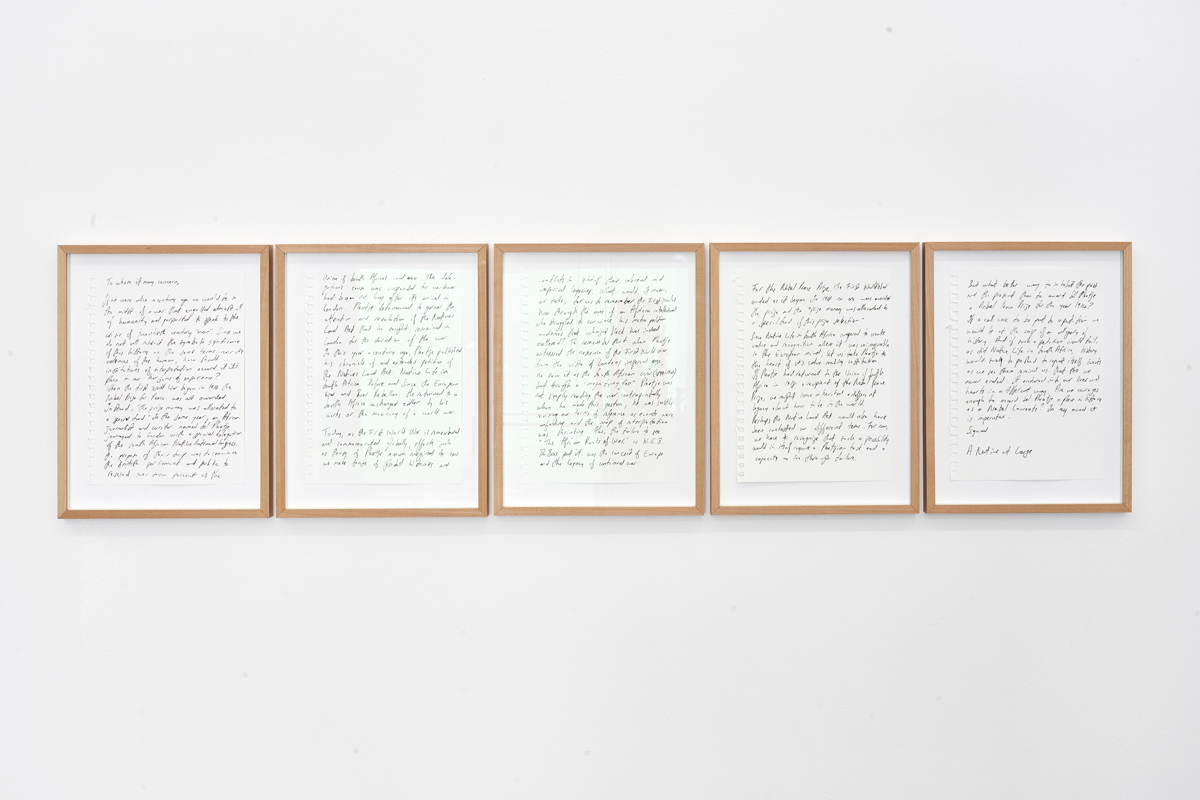
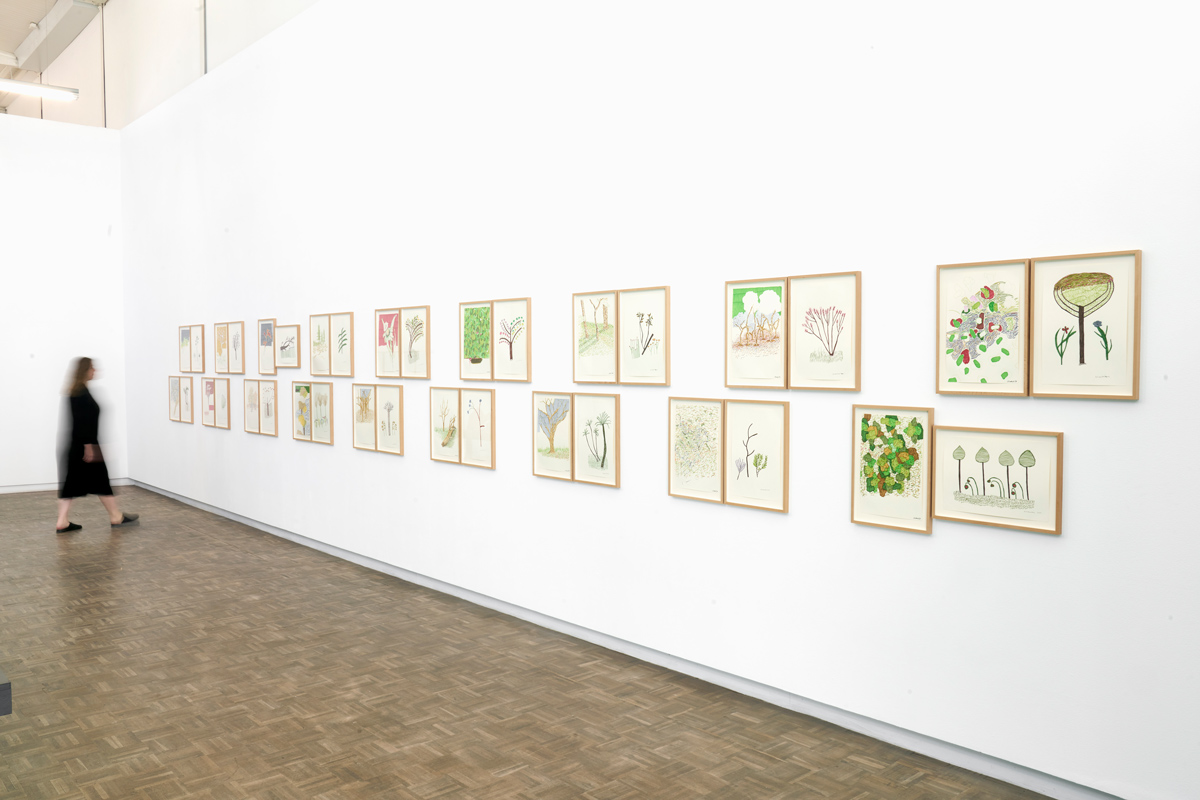
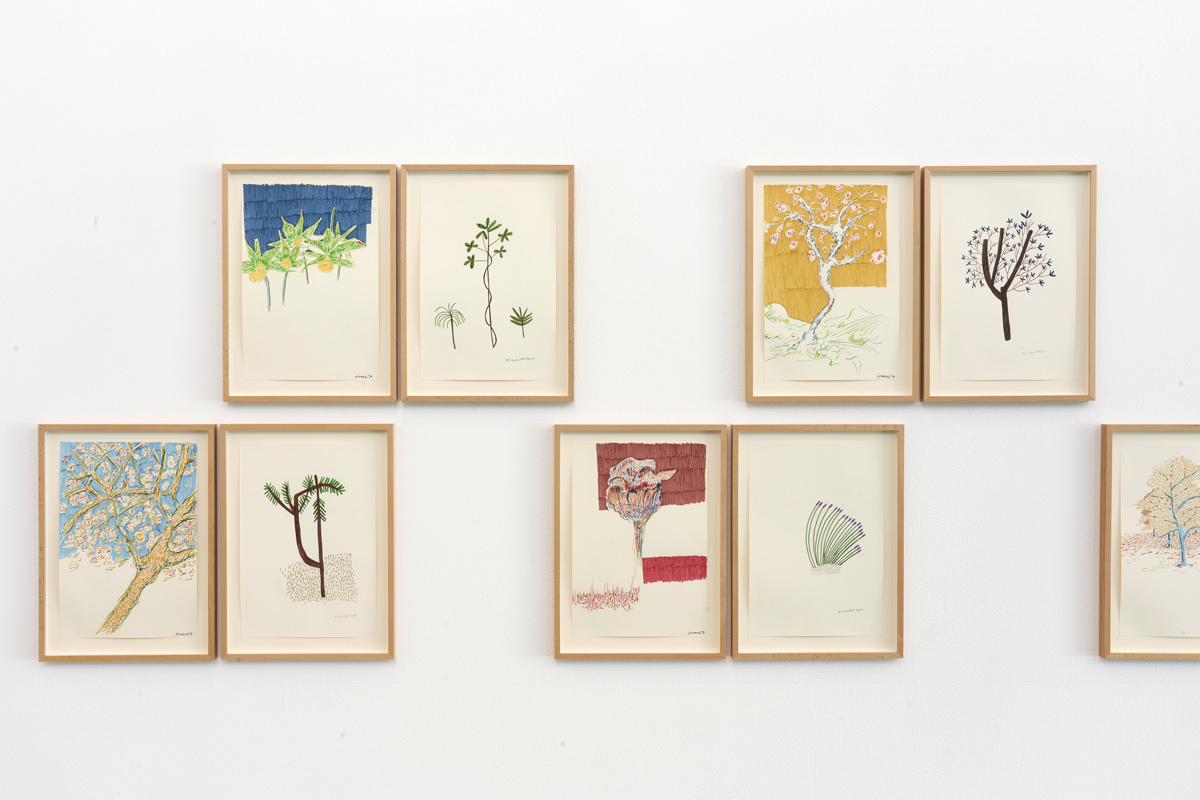

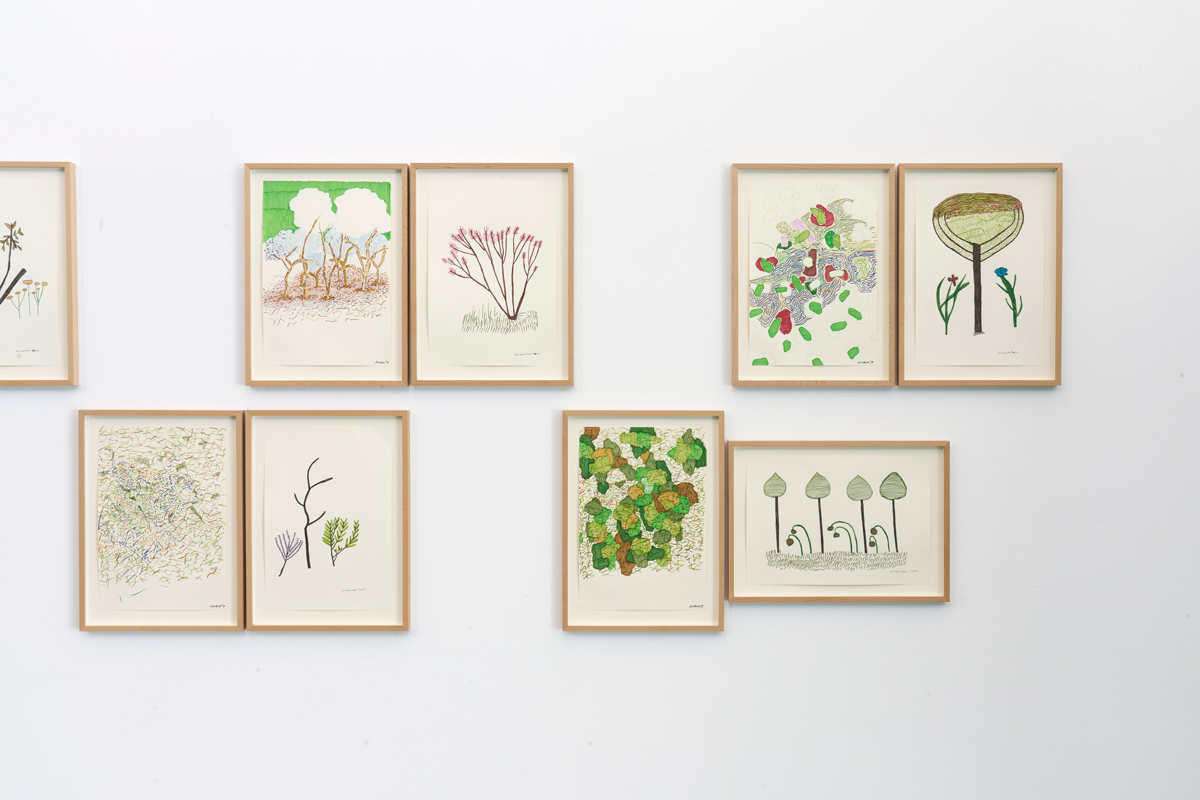


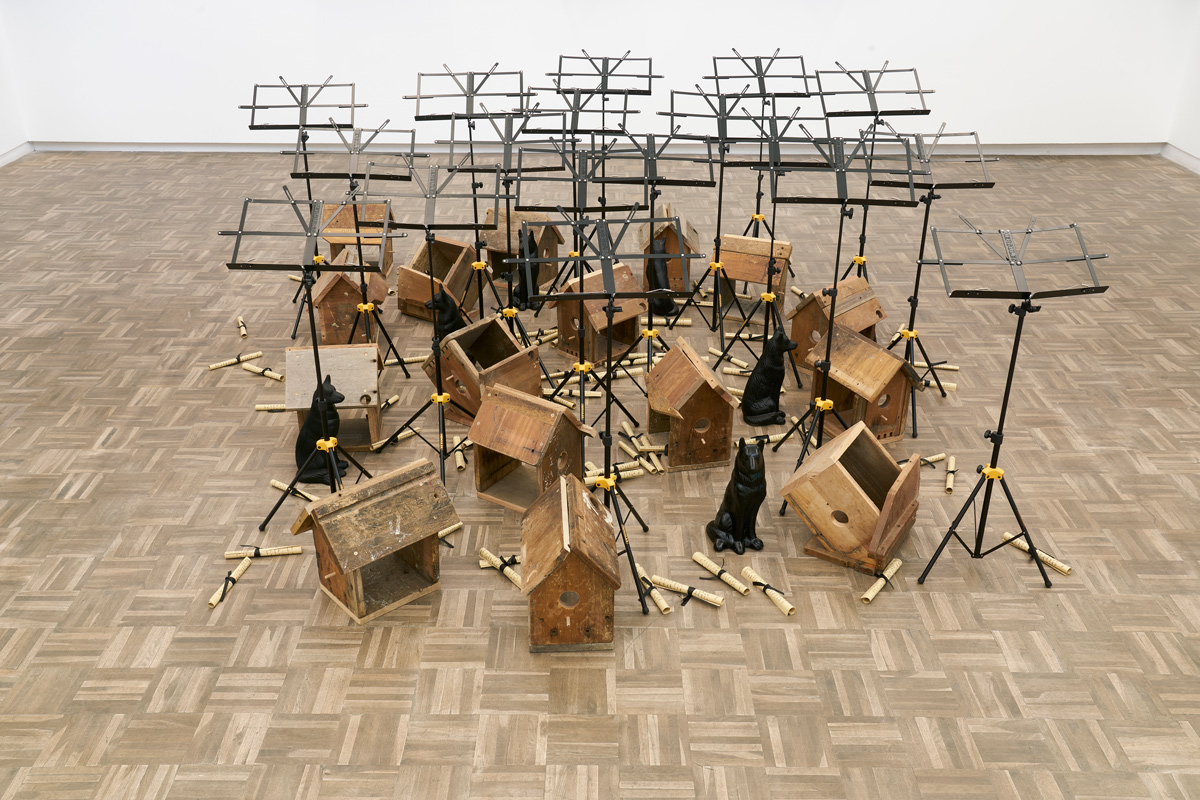

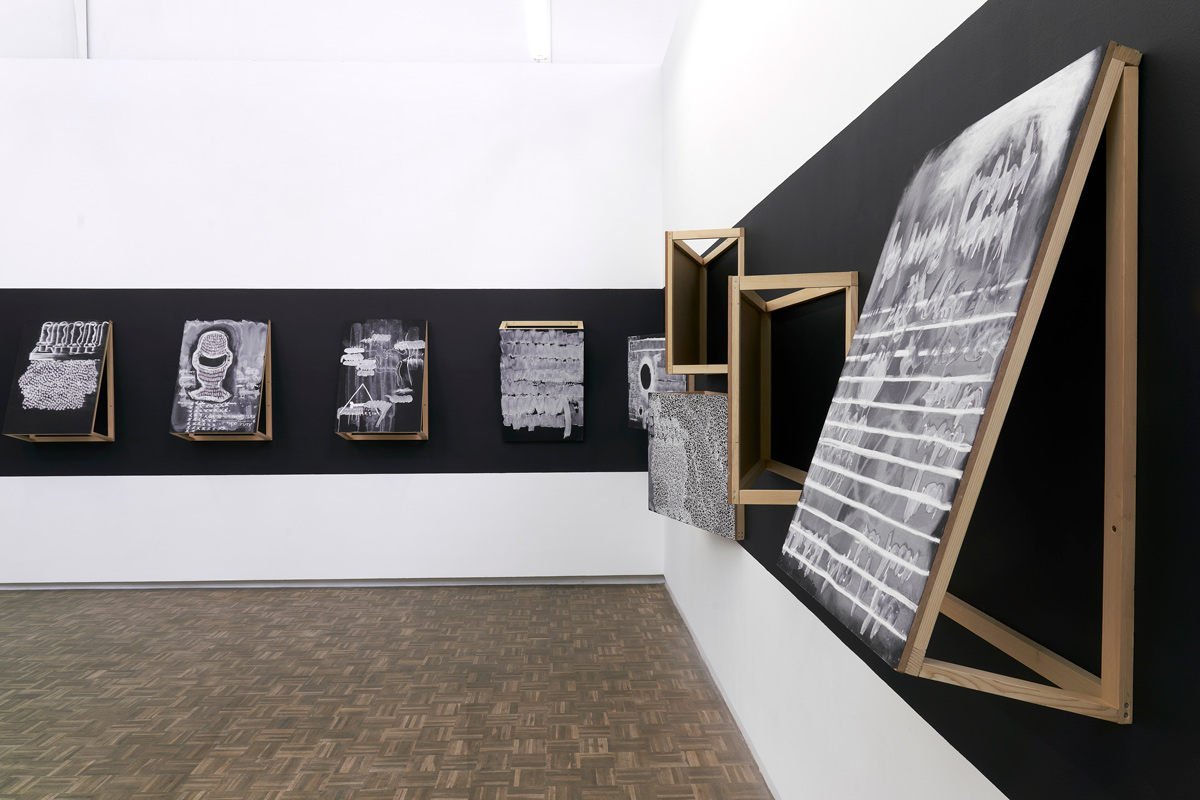


blank is pleased to present Bring Back Lost Love, a solo exhibition by Kemang Wa Lehulere. Encompassing sculptures, drawings, and installation, Bring Back Lost Love is conceived as a symphony that excavates personal and collective memory, real and imagined, to address neglected or discarded narratives of South African history. Through a retelling of stories that traverse fact and fiction, the exhibition invokes questions of land ownership and migration in relation to the various legislations that violently disinherited black South Africans of land. Bring Back Lost Love evidences Wa Lehulere’s process of unearthing as a strategy for historiographic disruption and critique. To ‘bring back’ is not only to return, but to exhume, retrieve, and reinstate.
Suspended within the central exhibition space is the installation titled Black Forest. Describing the works, Wa Lehulere states,
Collaborating again with his aunt, the artist adopted a call-and-response strategy synonymous with free jazz – in which the lead musician “calls” for a response from the ensemble to create a new and unscripted melody and rhythm – to create ERF, a body of ink drawings that depict imaginary landscapes. The drawings recall the legacy of the late artist Gladys Mgudlandlu whose bucolic, colourful landscape paintings are interpreted as a critique of the status quo by their very exclusion of political themes. Mgudlandlu was a school teacher who taught Sophia Lehulere before their families were relocated from Athlone to Gugulethu under the Group Areas Act. The drawings that form ERF are inspired by the scenery and natural elements found in Mgudlandlu’s work; specifically the murals that adorned her home, which Wa Lehulere’s aunt recalls from memory.
In Reddening of the Greens, the theme of movement and migration is carried through the installation of worn suitcases, wooden crutches and birdhouse assemblages made out of salvaged school desks. Explaining the significance of these materials and their multiple readings, Wa Lehulere recalls the journeys of German philosopher Walter Benjamin and South African writer Nat Nakasa, both of whom tragically committed suicide when in exile. Assembled together, the objects convey multiple meanings – the suitcases are representative of journeys but also displacement, while the crutch is interpreted as a means of support but also hindered progress. The incomplete birdhouses made of cut up school desks suggest the symbolic promises of freedom, and the failures of the institutions that govern, police, and educate us.
The installation Conference of the Birds is an assembly of sixteen bird-boxes constructed from salvaged school desks, interspersed with music stands, ceramic dogs, and paper scrolls, and surrounded by chalk boards protruding at angles from the walls. Taking its title from an album by the Dave Holland Quartet, Conference of the Birds is inspired by the 1993 Gatherings Act of South Africa, which allowed a maximum of fifteen protesters to gather without a permit: the sixteenth person makes the protest illegal. In addition to universal references to collectivity, freedom and peace, birds in Southern African folk tales can also allude to symbols of the female sex and gender conflicts, as well as mediators between the spiritual world and the material world. Universal symbols of instruction, the chalkboards are populated with drawings and sketches alluding to crowds of people, depicted as swarming masses of dots, or Xs in sequence. Here and there are portions of text, obliterated and obscured like the rolled up messages strewn about the floor. Through the use of these metaphors, the work speaks to ideas of connectedness, networks and communing. In South Africa, protests – often accompanied by song – are heavily policed. Though they are mass-produced as kitsch household ornaments, the presence of the ceramic Alsatian dogs in the installation is a reminder of ‘police dogs’ and the force of state violence that protesters were often met with during such gatherings.
Also included in the exhibition is a letter addressed to the Nobel Peace Prize committee. In it, Wa Lehulere appeals to the institution to retrospectively honour the late author Sol T. Plaatje with the unallocated 1914 award for his monumental work, Native Life in South Africa, which was written in response to the Native Land Act. Although the institution does not award the prize posthumously, Wa Lehulere nevertheless posits the importance of acknowledging Plaatje’s contributions to literature through his chronicling of the Black experience. In doing so, the artist attempts to intervene, or collaborate with time and history by proposing a redress of recognition for Plaatje’s oeuvre.
Curator and critic Khwezi Gule writes:
“Wa Lehulere’s work is not so much about history or histories but the points at which certain (historical) trajectories are interrupted on a personal level (exile, suicide) and a systemic socio-political level (forced removals, the Land Act), and the intersection of the two. In a sense, his practice explores how the historical does not just manifest in the personal but how the personal is constitutive of the historical. Another major theme running through the artist’s practice is the abortive attempt to suture, reassemble, to graft prostheses onto these interrupted narratives and trajectories. These become surrogates for what was lost in the ruptures. Aborted, though, because the act of grafting (new) histories on old injuries serves not to ameliorate or cover up the injury but to accentuate and deepen the sense of loss.”
Bring Back Lost Love is Wa Lehulere’s first exhibition with the gallery.
Exhibition press:
Blackman, M. Kemang Wa Lehulere Summons a Black Intellectual Tradition. ArtReview [online] (published 28 March 2023)
Moloi, N. Kemang Wa Lehulere at blank projects. Artforum, vol. 61, no. 9 (published May 2023)
Suspended within the central exhibition space is the installation titled Black Forest. Describing the works, Wa Lehulere states,
I am interested in the idea of mapping, relating to questions of displacement and land. And an inspiration for the layout of this piece comes from the Lars von Trier film, Dogville. The installation consists of blackboards as a suspended landscape with drawings and elements made from concrete, salvaged school desks and porcelain dogs. The chalk drawing is a geographical representation of the neighbourhood where I grew up in Gugulethu, Cape Town. This was also a location during apartheid, to which many black people were sent, after they had been forcibly removed from other areas that had been deemed white only. In the installation I have also integrated casts of my aunt Sophia’s hands depicting notation from the sign language alphabet, but abstracted, as I am interested in notions of (il)legibility. Upon the floor are bottles, reminiscent of Molotov cocktails, a popular weapon of protest during apartheid. Each bottle contains sand and small wrapped paper messages that function as a metaphor for the many untold stories in our community and speak to African spirituality and the communication with our ancestors. The bottles thus become markers of violence and protest and a desire for our stories to be told and heard.
Collaborating again with his aunt, the artist adopted a call-and-response strategy synonymous with free jazz – in which the lead musician “calls” for a response from the ensemble to create a new and unscripted melody and rhythm – to create ERF, a body of ink drawings that depict imaginary landscapes. The drawings recall the legacy of the late artist Gladys Mgudlandlu whose bucolic, colourful landscape paintings are interpreted as a critique of the status quo by their very exclusion of political themes. Mgudlandlu was a school teacher who taught Sophia Lehulere before their families were relocated from Athlone to Gugulethu under the Group Areas Act. The drawings that form ERF are inspired by the scenery and natural elements found in Mgudlandlu’s work; specifically the murals that adorned her home, which Wa Lehulere’s aunt recalls from memory.
In Reddening of the Greens, the theme of movement and migration is carried through the installation of worn suitcases, wooden crutches and birdhouse assemblages made out of salvaged school desks. Explaining the significance of these materials and their multiple readings, Wa Lehulere recalls the journeys of German philosopher Walter Benjamin and South African writer Nat Nakasa, both of whom tragically committed suicide when in exile. Assembled together, the objects convey multiple meanings – the suitcases are representative of journeys but also displacement, while the crutch is interpreted as a means of support but also hindered progress. The incomplete birdhouses made of cut up school desks suggest the symbolic promises of freedom, and the failures of the institutions that govern, police, and educate us.
The installation Conference of the Birds is an assembly of sixteen bird-boxes constructed from salvaged school desks, interspersed with music stands, ceramic dogs, and paper scrolls, and surrounded by chalk boards protruding at angles from the walls. Taking its title from an album by the Dave Holland Quartet, Conference of the Birds is inspired by the 1993 Gatherings Act of South Africa, which allowed a maximum of fifteen protesters to gather without a permit: the sixteenth person makes the protest illegal. In addition to universal references to collectivity, freedom and peace, birds in Southern African folk tales can also allude to symbols of the female sex and gender conflicts, as well as mediators between the spiritual world and the material world. Universal symbols of instruction, the chalkboards are populated with drawings and sketches alluding to crowds of people, depicted as swarming masses of dots, or Xs in sequence. Here and there are portions of text, obliterated and obscured like the rolled up messages strewn about the floor. Through the use of these metaphors, the work speaks to ideas of connectedness, networks and communing. In South Africa, protests – often accompanied by song – are heavily policed. Though they are mass-produced as kitsch household ornaments, the presence of the ceramic Alsatian dogs in the installation is a reminder of ‘police dogs’ and the force of state violence that protesters were often met with during such gatherings.
Also included in the exhibition is a letter addressed to the Nobel Peace Prize committee. In it, Wa Lehulere appeals to the institution to retrospectively honour the late author Sol T. Plaatje with the unallocated 1914 award for his monumental work, Native Life in South Africa, which was written in response to the Native Land Act. Although the institution does not award the prize posthumously, Wa Lehulere nevertheless posits the importance of acknowledging Plaatje’s contributions to literature through his chronicling of the Black experience. In doing so, the artist attempts to intervene, or collaborate with time and history by proposing a redress of recognition for Plaatje’s oeuvre.
Curator and critic Khwezi Gule writes:
“Wa Lehulere’s work is not so much about history or histories but the points at which certain (historical) trajectories are interrupted on a personal level (exile, suicide) and a systemic socio-political level (forced removals, the Land Act), and the intersection of the two. In a sense, his practice explores how the historical does not just manifest in the personal but how the personal is constitutive of the historical. Another major theme running through the artist’s practice is the abortive attempt to suture, reassemble, to graft prostheses onto these interrupted narratives and trajectories. These become surrogates for what was lost in the ruptures. Aborted, though, because the act of grafting (new) histories on old injuries serves not to ameliorate or cover up the injury but to accentuate and deepen the sense of loss.”
Bring Back Lost Love is Wa Lehulere’s first exhibition with the gallery.
Exhibition press:
Blackman, M. Kemang Wa Lehulere Summons a Black Intellectual Tradition. ArtReview [online] (published 28 March 2023)
Moloi, N. Kemang Wa Lehulere at blank projects. Artforum, vol. 61, no. 9 (published May 2023)